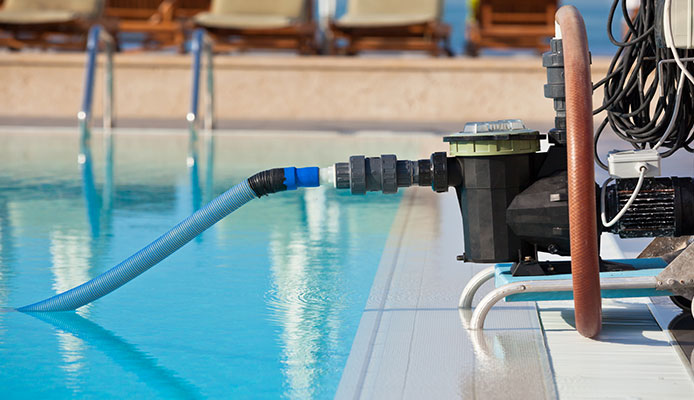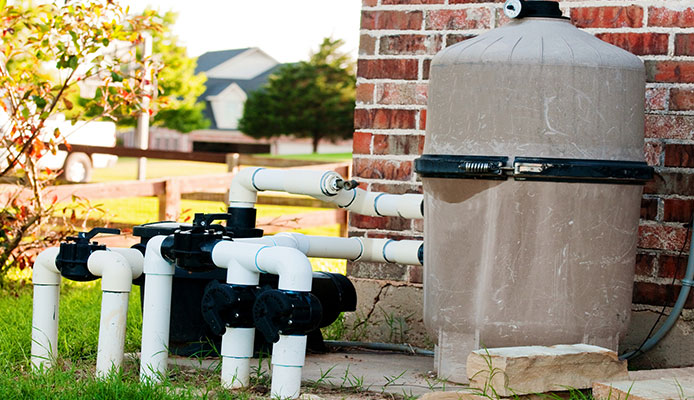
Pool pump pressure is among the most annoying problems you can deal with as a pool owner. In this article, we’ll show you what to do if this problem occurs and how to solve the low pressure pool pump and pool filter low pressure issue to increase the water circulation.
What Causes Low Pool Pump Pressure
Both low PSI and high PSI reading will result in a low pressure pool pump, and they can be caused directly by air bubbles, slow pool cleaners, a lot of water features, physical obstacles… It may take some time to figure it out, but fixing this issue shouldn’t be much of an issue once you do.
Understanding The Pool System
Before we head to the problem itself, it may be helpful to learn how does the pool system work. The purpose of the pump is to create a vacuum to suck water out of the pool, runs it through filter and back into the pool. Any interference, like a leak on the pressure side, or a blockage in the suction section or the filter will lead to low pressure.
Water Level Issue
This is the easiest problem and the first place you should look to solve it. For the pump to run properly, the water level should cover half of the skimmer doors. In other cases, the water pressure will drop. The solution is to simply add more water to your pool.
Clog In A Skimmer Basket
If the PSI reading says it’s low, and the water level is OK, check the skimmer basket for debris. If the skimmer basket is full, it will most likely affect the pipe between the skimmer and the pump, reduce the water flow into the pump, and this way allow less water out, resulting in low water pressure. To solve it, simply remove debris from the basket and it should be fine.
Clogged Strainer Basket
The same rules apply for the strainer basket as they do with a skimmer basket. A clog in the strainer basket will allow less water to reach the pump, so the water pressure will drop as a result. Removing debris and cleaning strainer basket should help.
Clogged Filter
The first thing you should check if you have a low pump pressure and high PSI value is to check the filter and see if it is clogged. The solution is not as simple as the previous ones, and it may take some time.
First, wash your cartridge filter. Then, soak the filter in a TSP solution and let it sit for the night, to get rid of the grease that gathered in the folds. Soaking it in a weak solution of muriatic acid (10:1) afterward will remove the minerals. Reversing the order will cause an unpleasant and sticky substance to appear, so stick to the one described here.
Impeller Clog
This is the problem that is probably the easiest one to miss and skip. Water needs to rotate out through the sides of the impeller, and a clog in it will lower the suction, the less water will go through the pump and the pressure will drop. It is indicated by low PSI. What you have to do is to clean the pool impeller.
Pump Suction Leak
If none of the previously described solutions doesn’t work, and it still shows low PSI, then the problem is most likely a leak at the pump itself. Check the lid o-ring, intake fitting and drain plugs as these are the places where the leak will most likely appear. To solve it, find the air leak and close it.
Diverter Valve Suction Leak
The diverter valves are positioned in front of the pump and they serve to control the water flow from the skimmer, main drain, vac lines, so it is not hard to see how important it is for them to work properly. However, seals in them are prone to air leakage, so the water pressure will drop. Find the leak and close it.
Plumb Fitting Suction Leak
If none of the above solutions helps, turn to plumb fittings, inspect them thoroughly. If you see that any part of it is leaking, cut it out and replace it.
Clogged Pump Pipe
Low PSI can also be a result of a clogged pipe that goes into the pump. As a result, less water will reach the pump. The solution is simple – take a stiff wire, push it down the skimmer or suction ports. If you fail to find a clog, it is time to call a professional.
A Feature Too Many
Remember, having too many water features can also weaken the pump pressure, so it may be a good idea to check if the problem comes from that side. Simply turn off one feature by one and check if anything happens. Or get a bigger pump if you have or want to use all those water features at the same time.
FAQ
Here are the answers to some of the most frequently asked questions about the low pressure pool pump and pool filter low pressure.

Q: What would cause low pressure in a pool pump?
There are many different things that can cause a pump pressure to drop. Some of the most ussual ones are water level, clog in different pool baskets, plumbs, pumps or filters, air leaks in suction parts or too many features turned on at the same time. However, if you’ve checked it all and the problem still happens then you should call a professional.
Q: How do you fix a low pressure pool pump?
The solution to this problem may be as simple as adding more water to the pool, emptying the basket or closing the air leak. Sometimes you may have to perform a more serious fix or to buy a new pump, but if you run into a more complex problem, call someone to help you.
Q: What should my pool pump pressure be?
It may differ from pool to pool and from place to place, so the best way to learn the best value for your own is to see the value right after the filter instalation or after a thorough cleaning. Most often, the range should be between 10 and 20 PSI (pounds per square inch).
Globo Surf Overview
With this article, finding the solution to the issue of a low pressure pool pump should be easy enough for you to do it without help, so you can return to your pool as soon as possible.

